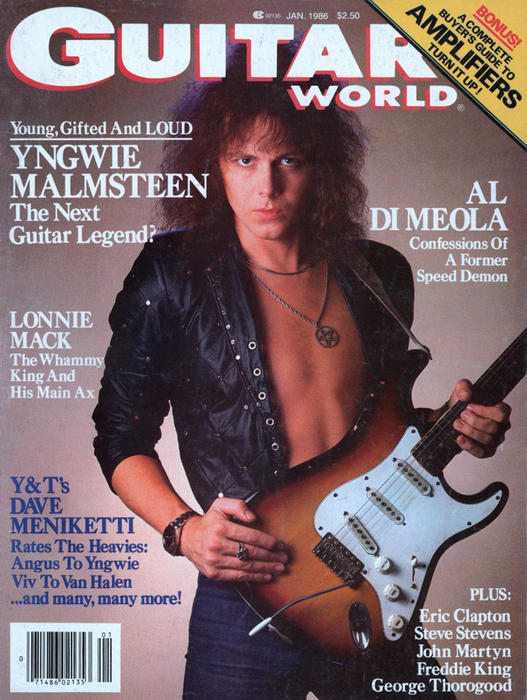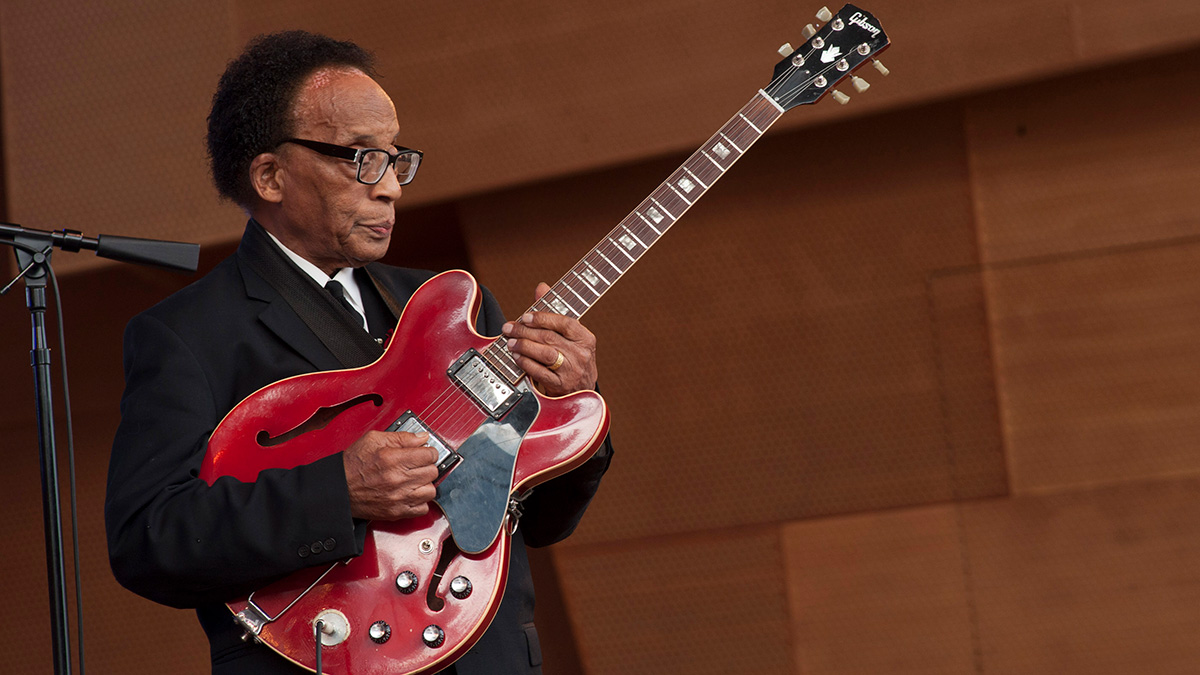
There are only a handful of individuals who have pioneered the way music is played on the guitar, yet you would need more than both of your hands to count those who have followed in their footsteps.
In fact, it may even become common practice to do so. Let’s take the classic model provided by Jimi Hendrix. The man undisputedly wrote the book on modern guitar playing, and we’d all be lying if we denied taking a page out of Jimi’s book every time we wrote a riff or lick.
His legacy has become so engrained in music history that whenever anyone plays a lick of his, it’s no longer considered “stealing.” That’s because he not only engrained his playing into the guitar vernacular, he practically rewrote the language himself. So at what point does this phenomena occur? In other words, at what point does “stealing” not become “stealing?”
Think of the number of players who incorporate Yngwie Malmsteen’s lines in their own playing. You’ll probably need more than both your hands to count them. His innovative neo-classical playing style is quite dazzling to this day, and many guitarists, including myself, borrow heavily from his potent musical arsenal.
A few guitarists who chose to model themselves after The Maestro managed to form notable bands and become competent artists in their own right. And while you can count those guitarists on one hand, the majority of imitators continue to churn out countless underwhelming ditties that’ll make you wish you'd never heard the E-flat Phrygian Dominant scale again. Granted, Yngwie hasn’t seen significant commercial success since 1988’s Odyssey, blurring the line between real and replica in the present day, it’s his back catalogue that represents his most groundbreaking strides in music.
Despite picking at 1 million mph, his technique is so fluid and natural that even as he’s burning through classics such as “Far Beyond The Sun” or “Trilogy Suite, Opus 5,” you can still see every single movement of both his hands if you watch carefully enough.
So what is it about the Swede’s signature style that makes stealing it so alluring? Is it the aged cream-colored Stratocaster with the sleek, scalloped maple fretboard? The colossal wall of Marshall cabinets stacked sky-high during his live performances? Or could it possibly be the thought of driving a Ferrari recklessly through Ft. Lauderdale, Florida, clad in tight leather pants with your freshly teased mane flying in the wind behind you. The main point is that Yngwie is Yngwie to the core, and no one will stop him from being so.
Get The Pick Newsletter
All the latest guitar news, interviews, lessons, reviews, deals and more, direct to your inbox!
Yngwie clones heard the pioneering and bombastic sounds of his guitar style but didn’t really understand how to extract the musicality from it, so they often simply took the speed — and speed away they did. In fact, it’s mostly all they did, and it greatly hindered their playing and improvisational sense. In other words, they took the wrong page out of The Maestro’s textbook. I’m not saying this is how they will play forever, but it usually takes longer to break out of that vicious cycle.
What’s worse is that recently many young guitar players only associate these speed-picking patterns with Yngwie Malmsteen without hearing the true depth of his work (For those who follow his post-Odyssey catalogue, no pun intended). It worries me as a guitarist, but more importantly a musician, that today’s aspiring guitarists, who have unlimited access to instructional materials and videos online, are surprisingly dismissive of Yngwie’s playing after just a few listens.
Paradoxically, they would rather watch his imitators show them countless mundane exercises, which are all interchangeable but on different parts of the neck, creating the illusion of musical variety. Many guitar students nowadays are discrediting his colossal musical achievements due to bad imitators who have really given the big guy a bad reputation (Errr, again, no pun intended) by generalizing his unique playing style to essentially three or four scale sequences and finger patterns.
What makes the metamorphosis of an individual from Lars Johan Lannerback to Yngwie J. Malmsteen special isn’t just about the innovative melodicism, but the attitude and mentality that comes along with it, and more importantly, the mentality it takes to stay motivated. When he plays, he is pouring every ounce of his being into the guitar, believing in every note he plays and making each one count. Even at hyper speed, every single note is being molded in real-time into “Malmsteen notes.”
Ever since he was young, he heard a sound in his head and practiced until it habitually materialized into his own playing. Basically, he learned to own it — the process of which is very difficult to quantify, or even verbalize, but I think you get the idea.
Ostensibly, here’s what you know:
01. His gear: You can read countless magazines and interviews where Yngwie shares info about his rig to the guitar community. In fact, he was one of the only artists ever to have a signature guitar made by Fender. He’s also got signature pedals, amplifiers, etc., and you can even play with those 2.0 mm Jim Dunlop jumbo picks he uses (although yours will be purple with a picture of a turtle on it if you can’t manage to find one of his signature white ones).
02. His licks: Already mentioned before, but still vital. Slow down his records; watch his live performances in slow motion and study both his hands; take a guitar lesson with Joe Stump.
03. His tone: You have the gear and the licks, but this one’s a bit trickier.
04. His obsession with Ritchie Blackmore. Yngwie has stated he learned the entire Deep Purple Fireball album, along with an infinite amount of Blackmore’s other licks, at a very young age. He dresses like Blackmore to this day, scalloped his guitars because of him (I don’t necessarily buy the lute story) and even uses his pickups.
- So yes, Yngwie himself at some point was technically a clone of sorts. But how has he managed to make a name for himself while Malmsteen clones haven’t? Or maybe they just haven’t yet? For one thing, he never tried to make a career playing Ritchie Blackmore’s riffs, but the real answer is more complicated than that. Before I get to that,
- Here’s some stuff you might not have known:
•His obsession with other guitarists whose names are not Ritchie Blackmore. If you listened to Yngwie in the '80s, you probably also listened to the Scorpions, and I argue that Uli Jon Roth, not Blackmore, is his greatest musical influence. Additionally, he listed to a lot of Michael Schenker but the influence is a little subtler.
•He steals, not just borrows. Listen to the opening riff Yngwie plays in “General Hospital” off Alcatrazz’s debut album, No Parole From Rock N Roll. It’s eerily similar to Michael Schenker Group’s “Desert Song” off their album Assault Attack. Interestingly, both songs were recorded with singer Graham Bonnet, and Alcatrazz even performed both songs live with Malmsteen, possibly confusing the audience initially as they’re left wondering why the band was starting the same song again. Also, listen to the main riffs in “Jet to Jet” by Alcatrazz and “Spotlight Kid” off of Rainbow’s Difficult To Cure album with Joe Lynn Turner. In “Jet to Jet,” Malmsteen samples an Uli Jon Roth lick off of Roth’s solo in The Scorpions’ track “Virgin Killer” off the album by the same name. If you managed to get a hold of both tracks, listen to Uli’s solo first, where the phrase begins at 2:18 while the same phrase on Malmsteen’s solo in “Jet to Jet” begins at 2:29. (I’ll even go on record stating that Yngwie played the lick better and contextualized it more musically.)
Being a mimic in any field of discipline is frowned upon, yet many people seem to disregard this taboo. Truth be told, stealing someone else’s idea won’t do you much good if you don’t have the proper execution to see it through. And the same rule applies if you are the first to come up with something new because you wouldn’t have truly pioneered it. Once someone else comes along and does it better, all the attention will be focused toward that individual.
Relating this to music, the essence of your musicianship will shine through, regardless of whose idea you’re taking. Did William Shakespeare write his own plots? No, but he rewrote them in his own language, which is exactly what Yngwie did.
Do you think Ritchie Blackmore and Uli Jon Roth hold a grudge against him for copping a few licks? Well, maybe — but when Yngwie plays them, they have and always will ooze with Yngwie-ness. Furthermore, being able to play Yngwie’s licks fast doesn’t make you as good a player as he is — far from it. The difference between what he does and what a clone does is the difference between the inventor of pasta and someone who can make a bowl of Easy Mac. Get the point?
John Li plays lead guitar in Order of Ennead. John, a musician, composer and featured columnist for Guitar World's "Betcha Can't Play This," lives in New York City and attends New York University as a full-time music and music business student. He occasionally gives guitar lessons. Follow John on Twitter @theJohnLi.
Celebrated jazz guitarist George Freeman, best known for his work with Charlie Parker and Gene Ammons, has died aged 97
“After I made the RD with Epiphone I found it wasn't actually that comfortable to play live”: Bring Me the Horizon’s Lee Malia is no stranger to signature offsets – but he wasn’t too fond of his first










